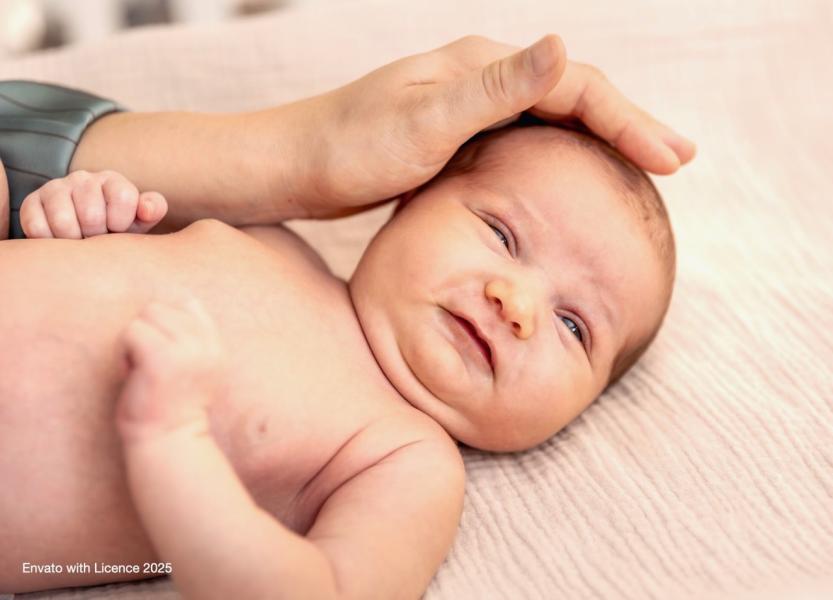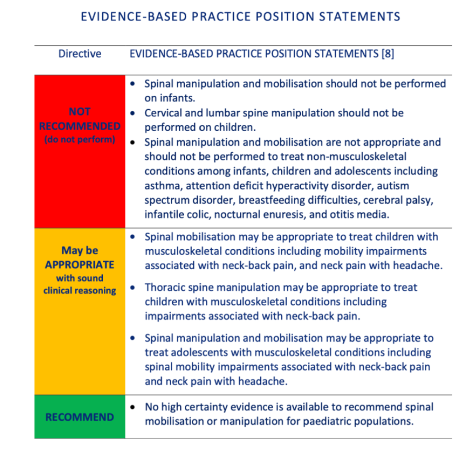
CRAFTA® curriculum
Within the CRAFTA® educational and clinical community, the application of manual therapy in infants and young children has long been approached with both clinical rigor and ethical awareness. For example, in the CRAFTA® curriculum—particularly during the second module, which includes manual assessment of the occiput in relation to C1—we thoroughly discuss and practice assessment, treatment, and related (contra)indications. This is further expanded upon in the Special Topic courses, where we delve deeper into the cervical anatomy and arthrokinematics of the young child.
We are fully aware that this vulnerable pediatric population often requires neuromusculoskeletal care in close collaboration with other medical and paramedical disciplines. In doing so, we thoroughly reflect on both internal clinical experience and external scientific evidence.
The recent statement from IFOMPT & IOPTP (2024) advises strongly against spinal manipulation and mobilization in infants and young children, citing limited evidence and naming potential risks. Taken literally, the statement could make training institutes like ours feel unfairly constrained or burdened with undue guilt.
This blog therefore presents a CRAFTA®-informed reflection, highlighting the importance of nuance, clinical responsibility, and international data on treatment safety and outcomes.
The IFOMPT/ IOPTP -Statement and implications
For your convenience, here is a brief summary of the IFOMPT Taskforce.
The IFOMPT/IOPTP Taskforce (2024, 2025) presents a clear recommendation regarding the treatment of the cervical spine in young children and adolescents;
- Spinal manipulation and mobilisation should not be performed on Infants. Neck and lower back manipulation should also be avoided on children.
- Spinal manipulation and mobilisation may be appropriate for treating musculoskeletal conditions in adolescents.
- Spinal manipulation and mobilisation are not appropriate for treating non-musculoskeletal paediatric conditions not be used to treat non-musculoskeletal paediatric conditions Among infants, children and adolescents."

Fig Polici brief World Physiotherapy Specialty Groups – IFOMPT & IOPTP 2024; Paediatric Manipulation & Mobilisation Evidence-based Practice Position Statement
What CRAFTA® Education Covers ??
In the CRAFTA® advanced training modules, we teach manual assessment of pediatric cranio-cervical junction with a focus on physiological and accessory movements to identify dysfunctions. Our standards:
- If a dysfunction is present, an individualized clinical reasoning process is used to determine whether there is an indication or contraindication for treatment.
- The indication for treatment is clearly limited to musculoskeletal complaints of the cervical spine, notnon-musculoskeletal complaints (see above).
- NO MANIPULATIONS (THURSTS) are taught or performed; instead, only gentle mobilizations of physiological and accessory movements are applied, without causing discomfort.
- There is always intensive parental communication, education, and follow-up for several months after the end of treatment, as this is considered an integral part of the treatment process.
Critical Perspectives on the IFOMPT Taskforce Statement
While the IFOMPT/IOPTP (2024) recommendations are understandable from a "safety first" perspective, they can be critically questioned due to a lack of transparency in the literature selection and the exclusion of recent positive evidence.In a formal letter to the KNGF, Dutch experts express concerns about the scientific foundation of the statement (Saedt et al., 2025). They emphasize that:
- Recent literature showing positive effects of mobilization in infants has not been included in the IFOMPT statement.
- The risks presented are largely based on case histories from chiropractic treatments, and thus not representative of a practice within the specialized physiotherapist in musculoskeletal therapy.
- In a descriptive study of the European Workgroup of Manual Medicine (EWMM) there are >420.000 monitored treatments without serious adverse events, thus not more than in babies and children who are generally treated by other forms of therapy (Sacher et al 2025).
This criticism is shared in international professional literature citing the debate on bias and biased policy making (Kusgen & Ammermann 2025, Wuttke et al 2025).
Experiences of CRAFTA-Certified Therapists
Among the more than 400 registered CRAFTA-certified therapists, one part work with infants and young children. To date, no adverse effects have been reported. These findings can and should be used proactively in response to the recent recommendations issued by the IFOMPT Taskforce.
Speaking from personal experience: I have been working with infants and young children for over 25 years, with a strong focus on functional neuromusculoskeletal diagnosis and the application of gentle, non-provocative techniques. In particular, Maitland-based accessory mobilizations of Grades II, III, and IV—performed without discomfort and combined with craniofacial manual techniques—have shown clinical effectiveness in reducing functional impairments and suppressing persistent nociceptive stimuli (von Piekartz, 2015). Throughout all these years, I have not observed any serious side effects.This is also the experience from other CRAFTA® teachers.
CRAFTA®’s Position on the IFOMPT Recommendations
Within the CRAFTA® framework, musculoskeletal therapists are trained to apply safe, evidence-based, and ethically responsible techniques when working with infants and young children. In light of the recent IFOMPT Taskforce statement—which generally advises against spinal manipulation in infants while permitting mobilization when clinically indicated—therapists are trained to apply such techniques safely and ethically.
A CRAFTA®-certified therapist will never:
- perform spinal manipulations (thrust techniques) in infants or young children but gentle, well-controlled mobilisations
- treat non-musculoskeletal conditions such as infantile restlessness, excessive crying, ADHD, or skin conditions like neurodermatitis;
- proceed with treatment when red flags are present;
- ignore the importance of structured collaboration with referring physicians or other specialists such as pediatric physiotherapists.
Final Reflections
- The IFOMPT Taskforce’s recent recommendations require careful and nuanced interpretation. When appropriately indicated and performed by trained professionals, gentle mobilizations—such as those taught within the CRAFTA® education—are both safe and clinically beneficial for infants and young children with musculoskeletal disorders.
- Broad restrictions or blanket warnings—especially when lacking robust clinical justification—risk undermining trust in evidence-based practice. What is needed instead is a coherent, integrative approach that bridges clinical reasoning, scientific research, and the lived experiences of both therapists and families.

This discussion is ongoing. CRAFTA® remains committed to offering thoughtful, responsible, and collaborative input to shape the future of pediatric musculoskeleal therapy.
In name of all CRAFTA® Teachers and Board
Harry von Piekartz
References
Borusiak, P., Biedermann, H., Boßerhoff, S., & Opp, J. (2010). Lack of efficacy of manual therapy in children and adolescents with suspected cervicogenic headache: results of a prospective, randomized, placebo-controlled, and blinded trial. Headache: The Journal of Head and Face Pain, 50(2), 224-230.
Joslin, R., Allen, E., & Carter, B. (2024). Understanding the importance of therapeutic alliance during physiotherapy treatment for musculoskeletal pain in children: a scoping review. Frontiers in Pain
Research, 5, 1452771. IFOMPT & IOPTP. (2024). Paediatric Manipulation and Mobilization Evidence-based Practice Position Statement - Policy Brief. https://doi.org/10.6084/m9.figshare.26038921
Sacher, R., Saedt, E., & Wuttke, M. (2025). Restricted use of spinal mobilization and manipulation in infants: How serious is the scientific debate? Manuelle Medizin, 1-4.
Küsgen, B., & Ammermann, M. (2025). There is no madness in spinal manual techniques in the pediatric setting. Journal of Manual & Manipulative Therapy, 33(1), 16-17.
Research, 5, 1452771. IFOMPT & IOPTP. (2024). Paediatric Manipulation and Mobilization Evidence-based Practice Position Statement - Policy Brief. https://doi.org/10.6084/m9.figshare.26038921
Saedt, E.van de Woude, B., Theunissen, P., & von Piekartz, H. (2025). Letter to Board KNGF, Reaction to IFOMPT statement. EWMM NL & CRAFTA.
Piekartz, H.,Budelmann K, (2015)Neuromuskuloskeletales Assessment und Management von kindlichen Kopfschmerzenp 574- 596 in . "Kiefer, Gesichts-und Zervikalregion. Neuromusculoskeletal Assessment und Behandlungsstrategien, H. von Piekartz." (2015).
Wuttke, M., Knuedeler, M., & Wenning, K. (2025). Tendential and unscientific opinion regarding spinal manipulative therapy in the pediatric population: In Reference to: Olson KA, Clewley D, Milne, N et al.(2024): Spinal manipulation and mobilization for pediatric conditions: time to stop the madness. J Man Manip Ther. 32 (3), 207-210. Journal of Manual & Manipulative Therapy, 33(1), 10-12.
